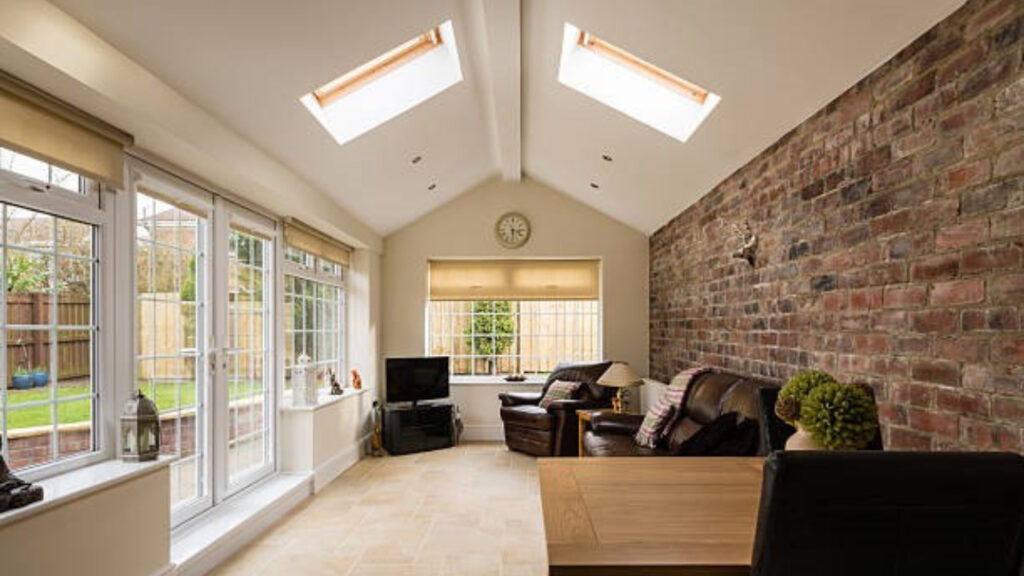Tired of the dull vibe your ceiling has?
It is high time for a ceiling revamp.
But rather than replacing your old ceiling, you can consider going for other economical revamping ideas. Painting your ceilings is one of the favorable options you can go with especially when you are focussing on budget-friendly DIY revamping ideas. However, different ceiling types have variable painting requirements.
Painting high ceilings, however, can be a bit challenging in the case of vaulted ceilings. The same ceiling height that gives your space a majestic appearance, makes it difficult to paint a vaulted ceiling. Despite all these constraints, people still choose to paint vaulted ceilings as DIY home improvement projects.

If you have an old vaulted ceiling in your home and are looking to paint it, then you must be thinking of making a good start. Let’s get into the details and see how you can do it perfectly.
Table of Contents
How to Paint Vaulted Ceiling
The vaulted ceiling is also known as high ceiling and has a unique structure. As discussed earlier, it can be difficult to paint higher ceilings. But here is the step-by-step procedure to simplify the painting procedure for you and leave you with a perfect painted ceiling.
1. Assess Existing Ceiling Condition
The first step of painting a cathedral ceiling or vaulted ceiling is to assess the previous ceiling condition. If your existing ceiling has cracks or other imperfections, make sure to fix them first. It is recommended to use a joint compound to fill any holes or cracks in the ceiling.
Also, if your ceiling has been painted before, then make sure to remove the old paint first. You can scrub the paint from the ceiling after applying the layer of chemical stripper to it. After this, sand the ceiling to remove any leftover paint.
2. Choose Paint
The next part of the vaulted ceiling paint process is to choose a good quality paint for your ceiling. Ceiling paints are available in different varieties such as enamel paint, oil-based paints, latex paints, etc. And then seeing the color shade cards will further add to your confusion. So, make sure you choose good quality paint in sufficient quantities.
While choosing the paint color for your ceiling, you can go for different options. You can choose a darker paint color for the ceiling with lighter walls, light paint with darker walls or the same color paint for both the ceiling and walls.
3. Gather Supplies
If you are going to paint your vaulted ceiling on your own, then make sure you have the right tools and equipment for this. Being well-equipped will make the job easier for you by all means. Here are a few supplies that you essentially need to perform the painting job:
Ladder/ Scaffolding
Vaulted ceilings are known for their great heights. So, to reach the highest corners, you need a sturdy support beneath your feet. A ladder or scaffolding can serve the right purpose. A ladder is generally preferred if you are painting the vaulted ceiling on your own because a scaffold is hard to assemble and is for professional use.
Paint Rollers/ Brushes
You need these rollers or brushes for the application of paint. Rollers particularly help to apply paint on the largest surface areas and are known for their smooth paint application. The width of paint rollers can vary which can affect the speed of the painting process. Generally, an 18-inch roller is considered ideal for a vaulted ceiling unless there are exposed beings.
Roller Pans
To apply paint on the roller surface, you need roller pans. Make sure to consider the size of your roller before choosing the pan.
Extension Poles
The rollers and brushes are not very tall so you need the extensions for these rollers and brushes. Having the extensions will help you to access the distant areas of the ceiling. These extension poles are also available in a huge variety according to theory size and material. So, make sure to consider your vaulted ceiling height while choosing the extension poles.
Other Supplies
Other common supplies you need to have for your painting work include painter’s tape, drop cloths, etc.

4. Prepare the Room
No matter if you are painting a cathedral ceiling or a vaulted ceiling, preparing your space for the painting job is mandatory. Here are the steps you need to follow while preparing your space for paint make-over:
- First of all remove any fixtures such as nails, ceiling fans, fixture boards, etc., on the ceiling surface. If it is not possible to remove them, then you can cover them.
- After this, remove dust from the ceiling surface as it can prevent the paint from sticking. You can use a duster or cloth to remove all the dirt or dust.
- Now remove all the furniture from the room to prevent the chances of splatter. Also, not having furniture in the room will make it easy for you to move the ladder across the room.
- Cover the exposed surfaces including your floor with a drop cloth.
- Apply painter tape to the ceiling area you want to keep paint-free.
5. Prepare the Paint
The next step in painting a vaulted ceiling is to prepare the paint. You simply need a paint stirrer to mix the paint after you open the lid of the paint can. Paint stirring eliminates your chances of encountering paint clumps during the process. Now, pour the paint into paint trays.
6. Paint the Vaulted Ceiling
It is recommended to start the painting process with the ceiling edges. For painting edges, you need a 2-inch wide paint brush and use it in an upward feathering motion. After you cover 3-6 inches of ceiling area, it is time to paint the ceiling surface.
For this, you need a roller brush and dip it in the tray to apply a uniform paint layer over it. Now, apply the paint to the ceiling surface. Make sure to apply the paint inspection and roll the roller as you cover more ceiling areas.
7. Apply Paint Coats
Once you paint the ceiling, let it dry. Based on your ceiling requirement, you may need to apply another coat of paint.
8. Clean Up
The last step of the painting process is to clear the mess. Once the paint dries, remove all the drop clothes, gently take off the painter’s tape, and clean the floor.
Painting Vaulted Ceilings to Perfection
Vaulted ceilings, just like the cathedral ceiling are the high ceilings known for their majestic appeal. However, having a vaulted ceiling in place for years can make it boring. So, many people consider getting a fresh coat of paint a considerable option.
Painting vaulted ceilings is a tough job. However, if you have the right tools and know the technique, you can do it on your own. You can follow the step-by-step instructions to paint your ceilings. However, if you think that you won’t be able to do it alone, then you can seek out help from professionals.





